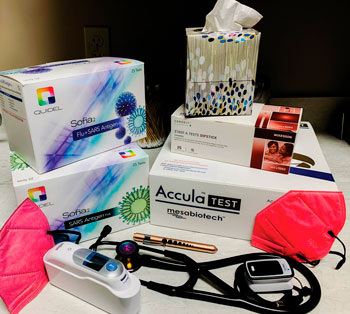Many patients may suffer for weeks or more after having been diagnosed with COVID-19. We are seeing that those who have persistent, unresolved symptoms usually have some underlying unresolved COVID-19 infection requiring Myers IV therapy along with a clear diagnosis of any co-infection or, like in a recent patient I treated, had an environmental toxicity that would normally resolve if the body was healthy.
Many physicians are ghosting patients who are not feeling better after two weeks of having had COVID-19 and some are sending them to psychologists saying it’s all a mental issue. Let me be clear, as is Mayo Clinic and John Hopkins Medicine: COVID-19 syndrome, also called COVID-19 Long Haulers, is a real thing.
I had a patient seek out our practice, Mesa Naturopathic, after several doctor’s offices wouldn’t see him after he was diagnosed with COVID-19. One doctor’s office said that, “they don’t see any sick people at all due to COVID-19.” My patient was released from a two-day stay at the hospital in early December having been diagnosed with sepsis in the emergency department. A COVID-19 test was done and a CT scan was performed that showed left lower lobe pneumonia.
He was sent to the COVID-19 floor when his test came back positive, and he was strictly treated for COVID-19 and the sepsis diagnosis was dropped. He was treated with hydration and antibiotic IVs, given an inhaler to which he said to the nurse he wasn’t having any cough or shortness of breath and was told, “Well he had to take it because he had COVID-19.”
After two days he was sent home not feeling much better with the main complaint of terrible fatigue. All this time his oxygen levels were normal, which was a good thing. Unfortunately, he continued to have strange symptoms of dropping temperatures. His normal temperature is around 97.8 degrees, but he was lucky if it got up to 96 from a very low hypothermic temperature of 94.
What about this up and down with his temperature? He was on day nine of his COVID-19 diagnosis when he found Mesa Naturopathic and felt like he was going to die unless someone helped him. He had debilitating fatigue; he couldn’t get his core body temperature to regulate and there was something wrong with his vision.
He was in hypothermia, but why? He started coming down with his first high temperature and cough in late October. Then he got better, then got sick again in November. He was well for a few weeks and then on Thanksgiving weekend, he developed a very high fever which sent him to the emergency department. But what was really going on here?
When I heard about his symptoms, I was curious about this neurological aspect of the fluctuating body temperature. Of course, we saw him right away, feeling that maybe he was still in sepsis, which can cause this drop in temperature and can be deadly. After many questions, my patient was not on any blood thinners, was not released on any further antibiotics, and was not tested for West Nile virus after he clearly stated to the emergency department staff that he had a terrible mosquito problem in his yard and house in October.
He had heard that the West Nile virus can cause neurological problems. He also told the doctor and nurse that he had probably experienced a large exposure to lead in mid-November helping his son tear down a shooting range shed due to the lead dust he was exposed to from the bullets.
After examination, my patient had hyperreflexia with pinpoint pupils not reacting to light. This is a clear sign of neurological deficit from a disease, infection, or poisoning. After ordering diagnostic blood tests for antibodies to COVID-19 to confirm this diagnosis and to West Nile, clotting blood tests were also ordered. The patient’s clotting marker, called a D-dimer, was terribly high most likely due to the COVID infection. He was then sent to have another CT scan to check for any blood clots in his lungs due to such a high reading.
He was put on a clotting medication and supplements, had daily Myers IVs for five days, and antibiotics were ordered due to the CT scan showing that the pneumonia had spread to his right lung. He had antibodies for both COVID-19 and West Nile viruses, a duo diagnosis.
After five days of treatment, my patient felt better, and his temperature was regulating. He was referred to his ophthalmologist for a clear diagnosis of his pupils and vision symptoms. He had complaints of unclear vision in the mornings, “like looking through a rainy window,” for about an hour or so. His pinpoint pupils were still unresponsive to light.
Another discussion about the lead exposure led us to test his blood and urine lead levels. Both were extremely high in lead. He was then started on a series of EDTA chelating IVs. After the first chelation IV, his pupils started responding to light. His body temperature is now stable.
Two weeks ago, my patient was fearful of losing his life. Today he is back to work and feeling much better. Please call us, Mesa Naturopathic, at (480) 306-8111, and come see us today if you need help recovering from COVID-19 or any complications from any infection or disease. Visit our website: mesadr.com
Please refer to the links below for further information about the long-term effects of COVID-19:
• https://www.mayoclinic.org/diseases-conditions/coronavirus/in-depth/coronavirus-long-term-effects/art-20490351
• https://www.hopkinsmedicine.org/health/conditions-and-diseases/coronavirus/covid-long-haulers-long-term-effects-of-covid19



